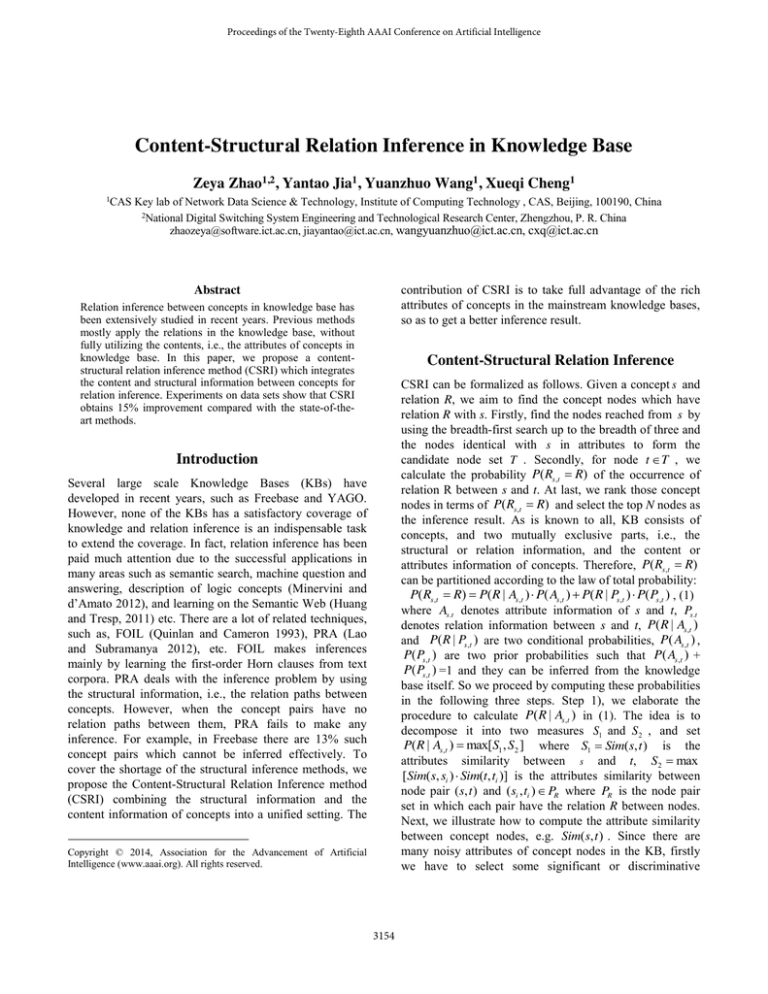
Proceedings of the Twenty-Eighth AAAI Conference on Artificial Intelligence
Content-Structural Relation Inference in Knowledge Base
Zeya Zhao1,2, Yantao Jia1, Yuanzhuo Wang1, Xueqi Cheng1
1CAS
Key lab of Network Data Science & Technology, Institute of Computing Technology , CAS, Beijing, 100190, China
2National Digital Switching System Engineering and Technological Research Center, Zhengzhou, P. R. China
zhaozeya@software.ict.ac.cn, jiayantao@ict.ac.cn, wangyuanzhuo@ict.ac.cn, cxq@ict.ac.cn
contribution of CSRI is to take full advantage of the rich
attributes of concepts in the mainstream knowledge bases,
so as to get a better inference result.
Abstract
Relation inference between concepts in knowledge base has
been extensively studied in recent years. Previous methods
mostly apply the relations in the knowledge base, without
fully utilizing the contents, i.e., the attributes of concepts in
knowledge base. In this paper, we propose a contentstructural relation inference method (CSRI) which integrates
the content and structural information between concepts for
relation inference. Experiments on data sets show that CSRI
obtains 15% improvement compared with the state-of-theart methods.
Content-Structural Relation Inference
CSRI can be formalized as follows. Given a concept s and
relation R, we aim to find the concept nodes which have
relation R with s. Firstly, find the nodes reached from s by
using the breadth-first search up to the breadth of three and
the nodes identical with s in attributes to form the
candidate node set T . Secondly, for node t T , we
calculate the probability P( Rs ,t R) of the occurrence of
relation R between s and t. At last, we rank those concept
nodes in terms of P( Rs ,t R) and select the top N nodes as
the inference result. As is known to all, KB consists of
concepts, and two mutually exclusive parts, i.e., the
structural or relation information, and the content or
attributes information of concepts. Therefore, P( Rs ,t R)
can be partitioned according to the law of total probability:
P( Rs ,t R) P( R | As ,t ) P( As ,t ) P( R | Ps ,t ) P( Ps ,t ) , (1)
where As.t denotes attribute information of s and t, Ps.t
denotes relation information between s and t, P( R | As ,t )
and P( R | Ps ,t ) are two conditional probabilities, P( As ,t ) ,
P( Ps ,t ) are two prior probabilities such that P( As ,t ) +
P( Ps ,t ) =1 and they can be inferred from the knowledge
base itself. So we proceed by computing these probabilities
in the following three steps. Step 1), we elaborate the
procedure to calculate P( R | As ,t ) in (1). The idea is to
decompose it into two measures S1 and S 2 , and set
P( R | As ,t ) max[S1 , S2 ] where S1 Sim(s, t ) is the
attributes similarity between s and t, S2 max
[Sim(s, si ) Sim(t, ti )] is the attributes similarity between
node pair ( s, t ) and (si , ti ) PR where PR is the node pair
set in which each pair have the relation R between nodes.
Next, we illustrate how to compute the attribute similarity
between concept nodes, e.g. Sim( s, t ) . Since there are
many noisy attributes of concept nodes in the KB, firstly
we have to select some significant or discriminative
Introduction
Several large scale Knowledge Bases (KBs) have
developed in recent years, such as Freebase and YAGO.
However, none of the KBs has a satisfactory coverage of
knowledge and relation inference is an indispensable task
to extend the coverage. In fact, relation inference has been
paid much attention due to the successful applications in
many areas such as semantic search, machine question and
answering, description of logic concepts (Minervini and
d’Amato 2012), and learning on the Semantic Web (Huang
and Tresp, 2011) etc. There are a lot of related techniques,
such as, FOIL (Quinlan and Cameron 1993), PRA (Lao
and Subramanya 2012), etc. FOIL makes inferences
mainly by learning the first-order Horn clauses from text
corpora. PRA deals with the inference problem by using
the structural information, i.e., the relation paths between
concepts. However, when the concept pairs have no
relation paths between them, PRA fails to make any
inference. For example, in Freebase there are 13% such
concept pairs which cannot be inferred effectively. To
cover the shortage of the structural inference methods, we
propose the Content-Structural Relation Inference method
(CSRI) combining the structural information and the
content information of concepts into a unified setting. The
Copyright © 2014, Association for the Advancement of Artificial
Intelligence (www.aaai.org). All rights reserved.
3154
attributes for inference. Suppose that the attributes of s and
t constitute the set A and B , respectively. We employ the
classic induction decision tree method to select the
discriminative attributes with respect to R to form set C ,
the reason we use the induction decision tree is to regard
the attributes as features of the classification problem with
respect to different relation R. Secondly, we compute the
common elements among the three sets A , B and C to form
set D . After these two steps, the attribute similarity
Sim(s, t ) is equal to the number of identical attribute
values of s and t whose attributes belongs to D , divided
by the number of elements of C . For example, for relation
R, suppose that A {a1 , a2 , a3 , a4 } , B {a1 , a3 , a4 } , and
assume that we get the significant attribute set
C {a1 , a2 , a3 } . By computing the common elements
among A , B , and C , we get D {a1 , a3 } . Furthermore,
, a3
and for concept t, a1
,
for concept s, if a1
, then we deduce Sim( s, t ) is equal to 1 3 . Step 2),
a3
we elaborate the procedure to calculate P( R | Ps ,t ) . Here
we adopt the idea of PRA and define the value of
P( R | Ps ,t ) by combing the results of different random
walks through relation graph. More detail can be referred
to (Lao and Subramanya 2012). Step 3), it remains to
determine two prior probabilities P( As ,t ) and P( Ps ,t )
which can be estimated by the maximum likelihood
estimation technique on the training set. Moreover, they
satisfy the equation P( As ,t ) + P( Ps ,t ) =1 .
information and structural information of KB. Moreover,
CSRI can infer the relation between the node pairs with no
relation paths but PRA fails to do so effectively.
Furthermore, we compute the increase between PRA and
CSRI. On Freebase the average increase between PRA and
CSRI is equal 22.2% and the average increase on
Wikipedia is equal 7.9%. Therefore, the average increase
on these two data sets by CSRI is equal to 15%. Notice that,
CSRI outperforms not much on Wikipedia is because
Wikipedia has poorer attributes of concepts than Freebase.
It should be mentioned that we also examine the
performance of CSRI for other relations, such as locationperson relations, and the results of CSRI still competitive.
Table 1: Comparison of different inference methods
dataset
Freebase
Wikipedia
MAP
relation
Children
FOIL
0.208
PRA
0.501
CSRI
0.702
Spouse
Parent
0.148
0.246
0.478
0.413
0.720
0.637
Colleague
Spouse
0.191
0.183
0.612
0.603
0.688
0.692
Brother
0.213
0.513
0.584
Conclusion
In this paper, we propose the CSRI method for relation
inference which integrates the attributes information and
the relation information of concepts in the knowledge base
and experiments demonstrate the effectiveness of it.
Experiments
The experiments are carried out via cross-validation on two
public data sets, Freebase and Wikipedia. Both of the two
data sets are representative KBs. In Freebase, the data is
organized in the forms RDF-liked of triples (subject,
predicate, object) which are further classified into a series
of domains. We select those 1,300,000 triples in the
domain of person. In Wikipedia, we selected 1,100,000
triples in the domain of person. For one relation R we
remove 20% of their relations in the KB, and then use the
pruned KB to infer the removed relations. We also use the
measure MAP (mean average precision) to evaluate the
inference performance, because the inference result was
given as a rank list, and MAP evaluates the overall quality
of the rank list. Our comparison baselines are two typical
relation inferences method PRA and FOIL. The experiment
results are carried out on six typical types of relations
between people. By observation, we find that when
P( As ,t ) 0.01 and P( Ps ,t ) 0.99 the performance of CSRI
obtains the best. The results are depicted in Table 1.
From Table 1, it is obvious that CSRI obtains the highest
MAP values on both data sets. This is unsurprising since
the mixture of content information of concepts tackles the
structural sparsity and the CSRI leverages the content
Acknowledgments
This work is supported by National Grand Fundamental
Research 973 Program of China (No. 2014CB340405),
National Natural Science Foundation of China (No.
61173008, 61232010, 61303244), and Beijing nova
program (No.Z121101002512063.
References
Minervini P, d'Amato C, Fanizzi N. Learning probabilistic
Description logic concepts: under different Assumptions on
missing knowledge. In Proc. ACM. 2012: 378-383.
Huang Y, Tresp V, Bundschus M, et al. Multivariate prediction
for learning on the semantic web. Inductive Logic Programming.
Springer Berlin Heidelberg, 2011: 92-104.
Quinlan J.R; Cameron-Jones R.M. 1993. FOIL: a midterm report.
In Proc. ECML. page 3-20.
Lao N, Subramanya A, Pereira F, et al. Reading the web with
learned syntactic-semantic inference rules. In Proc. EMNLP.
pages 1017-1026.
3155






